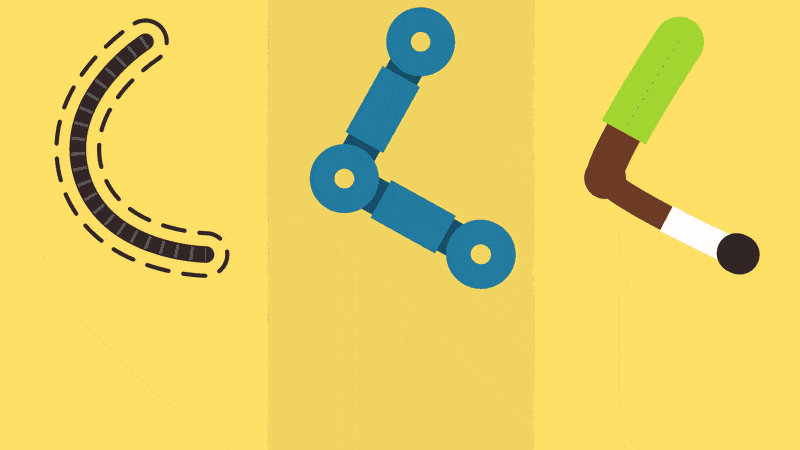“If I’m known for anything, it’s the utilization of some of the more obscure features in After Effects and a weirdo obsession with mathematical phenomena,” explained Adam Plouff.
Recently, the Atlanta-based animator has been expanding his skill set beyond keyframes and diving deep into code. Last week he released RubberHose, an After Effects plugin that makes pliable character rigs a snap.
I was interested in how Adam started down the tool-building path, so I asked him a few questions to find out more.
Journey into code with Adam Plouff
Since all the way back into college, I’ve had a fascination with people making art with code. I think it’s kinda romantic, in a way.
Usually, about once a year, I would get the urge to dive into the Processing language for a couple of weeks. I’d pick up some fundamental programming concepts, but I always walked away frustrated after not being able to integrate these ideas into my normal motion work.
Then in the summer of 2014, Sander Van Dijk released Ouroboros. It opened my eyes to what was possible inside of AE with some relatively attainable javascript knowledge. It was deeper than any of the expressions I had written, but it was a system that relied entirely on the shape layers to accomplished something new that could (most importantly) be interacted with.
This was the point in my career where I started thinking in terms of building systems and tools rather than a one-off animations done by hand. Sure, sometimes it is overkill, but I find that I’m never caught off guard by client requests.

Did you come across any particular resource that really helped with learning the fundamentals to expressions / scripting?
Motionscript is the common answer for getting started with expressions, and it’s a good one. Recreate everything on there, even if you don’t understand what’s going on. This will help you become aware of what elements in After Effects can be controlled with code.
Google anything that doesn’t make sense, and it’s a guarantee someone has written in length about that particular function.
Digging into JavaScript is the next step up. Expressions are based on the JavaScript syntax, so taking the time to wrap your head around this stuff really pays off. Codecademy has a great free course to get started. This is when you start building expressions with logic that check things for you, loop through layers and find properties, and build up some fancy math.
There’s a ton of really powerful stuff that can be created with just expressions. But expressions cannot create layers or change things about your project. This is where scripting comes in, and I highly recommend the David Torno AE scripting series. It’s free, and it is how most people get started putting all this javascript stuff to work for AE scripting.

I do agree with that. I see motion artists finding a place in other, more interactive, industries like games and apps. But I also see some of the systematic approaches to problems from these industries being brought back into linear animation as well.
I think there will always be a tribe of people who flat-out refuse and just feel more comfortable animating everything by hand, but I am starting to notice a bit more curiosity toward alternative solutions among diehard manual animators.
I don’t think all animators need to code, and I do think it’s good to learn how to do things the hard way because it’s a lot faster (but a lot less flexible). It’s the openness to new methods (scripts, expressions, etc) that I see becoming more prevalent. At the end of the day, it doesn’t really matter how the work got done, just that it’s on deadline.
Maybe it’s the fact that we’re all starting to get a little older, too. The energy it takes to brute-force a solution isn’t really sustainable. All the work we do on the computer is manipulating data; whether it’s keyframes or code, it’s all just data. So maybe working with the data is a good idea after all.
It’s really as steep as you want it to be, or as willing as you are to stare into the abyss.
Opening After Effects for the first time is incredibly overwhelming, but if you boil it down you realize it’s kind of like Photoshop with a timeline. Then you get that god-like feeling of “I can animate ANYTHING!!!”
Reality inevitably sets in and you realize that design isn’t just about clicking buttons and animation isn’t just about moving things. But if you enjoy the process you keep pushing and learning as you work through new projects.
That’s kind of what this code stuff is like. If you look at the entire breadth of knowledge that you do not possess you’ll end up crying in the corner. So you can start by accepting the fact that one layer’s rotation is just a number, and another layer’s x-position is just a number as well. If you put those numbers together somehow then something will happen. Build on that and learn new stuff as you go and eventually you’re building your own custom tools.

Yes, there are several other rigging systems out there that are amazing. I really love Duik and PuppetTools and still use them both quite frequently. They are super robust and allow for tons of customization in fully designed characters.
But sometimes you don’t want to draw up a full character and build an entire rig before you start working out an idea or a performance. Until RubberHose, there hasn’t really been a quick solution to just build an arm or leg that bends when you move it.
I know a lot of motion designers are too intimidated to try character animation because they feel the learning curve is too steep. Even if you have some character experience, a project’s deadline or budget sometimes doesn’t allow for the time it takes to set up a character in traditional IK.
Even if RubberHose never makes it to screen, a lot of animators are using it specifically for building a skeleton to do motion tests — which will either be drawn-over traditionally or used as reference to place complex art frame-by-frame.
RubberHose is also based entirely on Shape Layers, which means a character can be redesigned in the middle of animation. You animate the end points and whatever happens in between those is (for the most part) handled automatically. This also means that you have full resolution independence. This is a major drawback to using the Puppet Tool on externally designed art.
RubberHose does not use traditional IK. That is a positive and a negative, depending on what your intended outcome is. I’ll be the first to admit that RubberHose is not perfect for every project or art style. But it is an option. A much simpler option than anything currently on the market.
The only simpler method is to just animate a path one frame at a time. Or draw lots of pictures.






